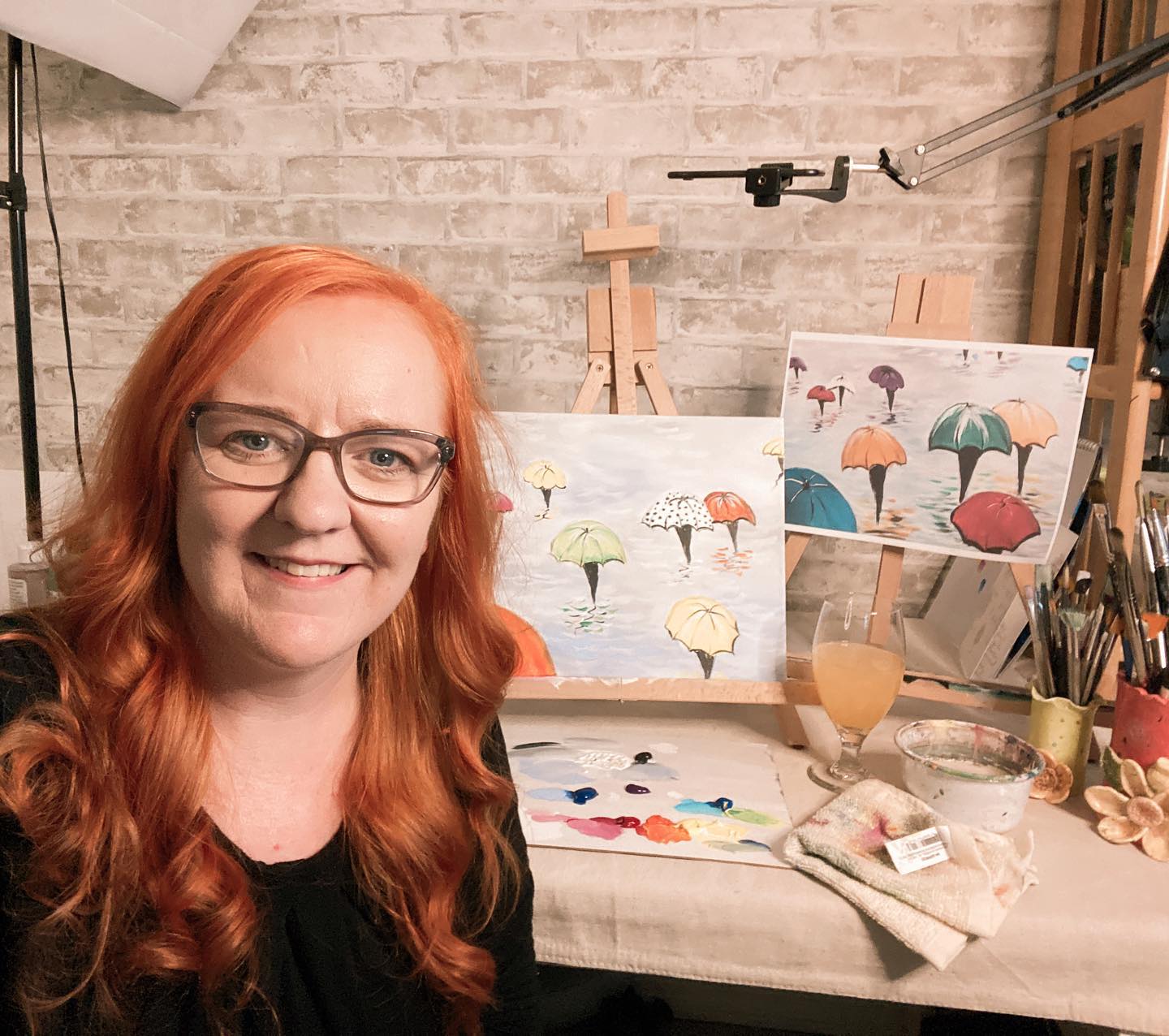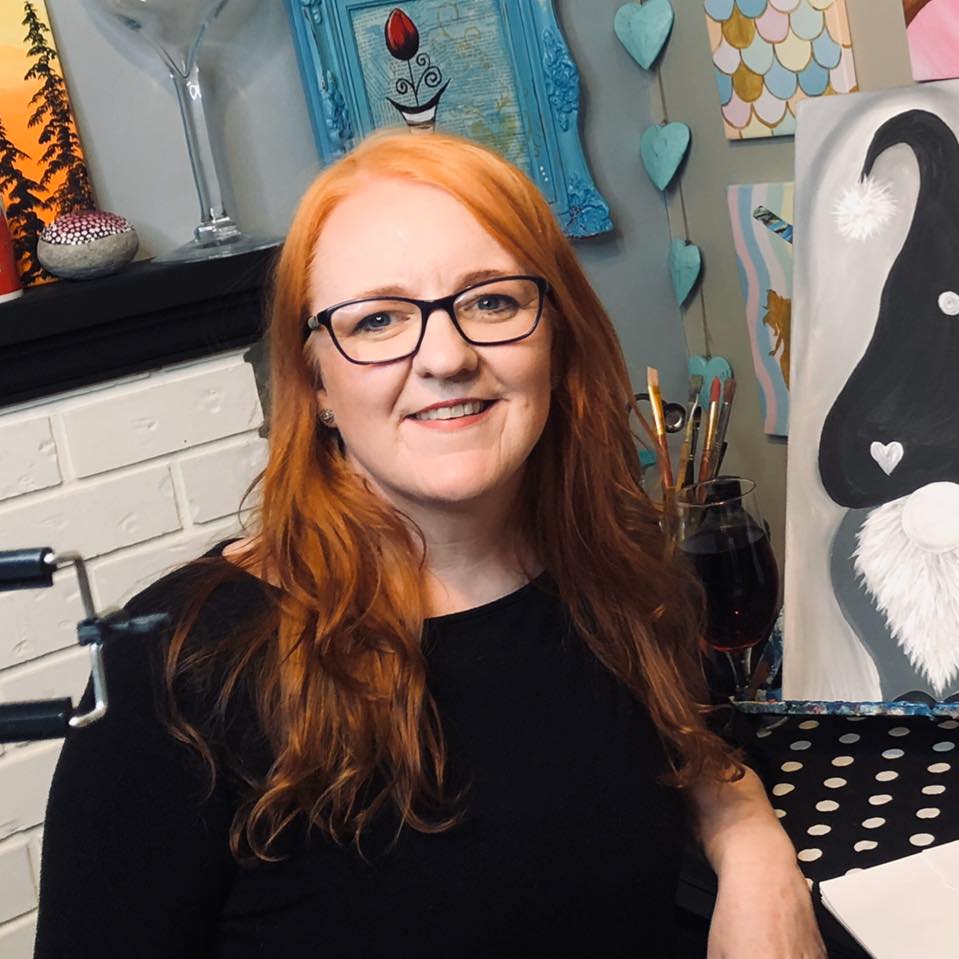When BC went into lockdown in March 2020, Freda Lombard watched the news in her Surrey home and cried. “My husband said, ‘you need to go paint,’” she shares. “So I painted and thought, other people need to paint, too.”
Jump ahead:
- Pivoting to an online art school
- Creating the “Netflix of paint night”
- Using live classes as a lead magnet
- Interacting through a Facebook group
- Asking her audience: What would you pay?
- Keeping it simple
- Overcoming her fears
- The power of feedback
Lombard hadn’t always been a painter; when she moved to Canada from South Africa in 2009, her husband gifted her her first easel. Instantly, she fell in love with the way in which painting helped her unwind, relax, and be creative.

She started inviting her friends over to paint with her, and realized that she had a knack for teaching art. Within three months of getting her easel, she started teaching regular ‘paint nights’ in local restaurants, coffee shops, and schools. Soon, she opened her own studio, and in her first year of teaching art she generated $100k in sales.
“People asked me, where did you study business and fine arts? But the truth is I have no fine arts or business degree, and I have no idea what I’m doing. But when I focus on how painting positively affects people, I realize it’s all going to be okay.”
When covid-19 paused her in-person teaching, she knew she had to pivot her business to an online format. While this felt like an intimidating process at the time, she was hopeful about the fact that online teaching would allow her to reach more people and help them cope through the power of art.
“I knew that if I could make these classes available to people online, it could help them during the pandemic.”
Now, she offers three Thinkific products under the brand Zealous Art: a membership program, individual courses, and course bundles. Here’s how she did it:
Pivoting to an online art school
Her teaching philosophy is all about fun art, not fine art. “If you want a fine art lesson, I’m not your girl,” she says. “I try not to talk too much about the rules of painting because I make things up as I go. I want people to have fun and not be stressed or intimidated by art talk and fancy terminology.”
She chose to use Thinkific as her online course host for Zealous Art since it’s a local Vancouver company. “It’s easy to use, and there was a guide that I printed out that helped me complete everything,” explains Lombard.
Creating the “Netflix of paint night”
Her first step to promoting her online art school was teaching live classes on Facebook multiple days per week — for free. “People wanted to send me money for the classes, but I just felt like people needed it for their mental health. I wanted to give back,” she shares.
In these classes, she’d lead people through a painting, from start to finish. Inspired by how quickly her live classes grew in popularity, she decided to create a membership program to give her students more opportunities to paint with her.
“I had 200 members sign up overnight because they wanted more classes,” she says.
She describes her membership program as the “Netflix of paint night.” It gives students the opportunity to pick and choose between a library of 120 classes as well as three new classes that are added every month.
“People love the membership and how easy it is to use. It’s one place for everyone to go and get what they need.”
For those who aren’t ready or willing to commit to the membership, she also sells individual courses and course bundles. Plus, she regularly promotes special offers; on Easter, she bundled 20 recorded Facebook lives for $20 — and sold over 220. “That was a great little income boost for me,” she explains.
Using live classes as a lead magnet
Lombard describes her free live classes as her lead magnet — and the way in which she’s built her audience.
Read more: 6 Step Lead Magnet Funnel To Capture & Convert Prospects (+Templates)
She promotes her live Zealous Art classes by creating a Facebook event for each one. For a few weeks before the event, people are notified when their friends sign up, and they get reminders when the event is approaching. “That’s how my audience grows,” she says.

She doesn’t charge for her live classes because her aim is to make painting accessible. Plus, she loves interacting with people, and her live classes give her the chance to sell her digital Thinkific products.
Interacting through a Facebook community
The live classes also give her students the opportunity to join her Zealous Art Facebook group – which has grown from 1,000 to 15,000 members in the last year alone. “The biggest growth happened since November 2021, but I don’t know what I did differently,” she laughs.
In her Facebook group, students share their paintings, interact with each other, and ask questions. It’s also where she invites people to join her email list to receive reminders about her live classes, new courses, and updates.
Read more: How to Start (and Grow) a Facebook Community
Asking her audience: What would you pay?
Before she launched her membership program, she asked her Zealous Art Facebook group audience what they’d pay for a membership. She did so through a poll, and learned that her students were willing to pay between $10 and $20. She decided to settle on $19 per month for the membership, and $12 for individual courses, which she also sells in bundles that range between $15 – $49.
Her membership brings in an average of $4-5k per month, but some months she’ll have $15k in sales if she offers a new bundle of courses.
She plans on relaunching her membership this July, which will slightly increase in price. Her goal is to make $20,000 in sales that month. Her new and improved membership will have more tips and tricks and will teach her students how to repurpose their paintings to create cards, art books, gifts, and even murals.
“It’ll still be like the Netflix of paint night videos, but I want to add in extra promotional materials to give it more value.”
For payment processing, she uses Thinkific Payments, a feature which allows creators to accept payments and manage payouts, orders, and refunds directly from the Thinkific dashboard. On her checkout pages, she uses Order Bumps to encourage upselling of her other digital products.
Keeping it simple
When she films her painting classes, she keeps the process as simple as possible; she uses an iPhone, iPad, tripod, and ring light to record them. “I don’t have any special speakers or equipment,” she says. “I use very simple tools.”

Generally, she spends two to three days recording and editing each video before uploading them into Thinkific. When it comes to creating social media content, she often repurposes her videos — and stresses that other content creators do the same in order to save time. She says she uses both Instagram and Facebook to promote her course, but gains the most reach through Facebook.
Overcoming her fears
Although she didn’t have any experience with starting an online course, she says she only had brief moments where she was intimidated by the technology piece of it. “I was most intimidated by putting myself out there,” she shares. “That was the scary part.
“There are so many people that are concerned about putting their businesses out there because they want to keep their personal lives separate,” she continues. “They think they have to share everything, but they don’t.”
When it came to overcoming her fears of stepping outside of her comfort zone, she focused on the positive feedback and comments that she received from students.
“My knees still shake sometimes before I teach a live class. But I just have to remain focused on what my courses do for people in order to push through.”
The power of feedback
Focusing on student feedback is the most important part of online course creation, according to Lombard. “I was always concerned about getting bad reviews,” she says. “But bad reviews aren’t always bad. Take all of the feedback you receive from your students. Learn from it and move on.”
She’s most thankful that her Thinkific course allows her more time and freedom. “I’m so grateful that I have this membership platform,” she says. “Now, I’m ready to go to the next level.”
Her best advice for those who want to launch an online course? “Just do it,” she says. “Put yourself out there and share how you can help people.”
Sign up to the newsletter for more creator story inspiration.







